Grand Canyon Water Erosion Kid Drawing
| Quick facts for kids Grand Canyon | |
|---|---|
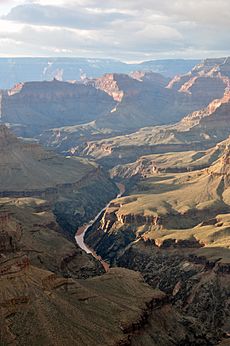 The Colorado River flowing through the Grand Canyon | |
| Floor elevation | approx. 2,600 feet (800 m) |
| Length | 277 miles (446 km) |
| Width | 4 to 18 miles (6.4 to 29.0 km) |
| Geology | |
| Age | 5–6 million years |
| Geography | |
| Location | Arizona, U.S. |
| Rivers | Colorado River |
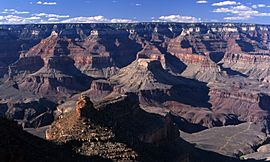

Another view of the Grand Canyon
The Grand Canyon is a famous canyon in Arizona, formed by the Colorado River. It is a UNESCO World Heritage Site, and a National Park of the United States. It is also one of the Seven Natural Wonders of the World.
The Grand Canyon is 277 miles (446 km) long, up to 18 miles (29 km) wide and is over a mile (1.83 km) (6000 feet) deep in places. Nearly two billion years of the Earth's geological history have been exposed as the Colorado River and its tributaries (smaller rivers) cut their channels through layer after layer of rock.
Evidence suggests the Colorado River established its course through the canyon at least 17 million years ago. Since that time, the Colorado River continued to erode and form the canyon to the point we see it at today.
Local erosion in the western Grand Canyon began about 17 million years ago, but a through-flowing Colorado River to the Pacific Ocean did not exist until about 5.4 million years ago. Most of the downward cutting has been in the last 2.5 million years.
Contents
- Geology
- Biology and ecology
- Plants
- Animals
- Life zones and communities
- Lower Sonoran
- Upper Sonoran and Transition
- Canadian and Hudsonian
- Tourism
- Related pages
- Images for kids
Geology
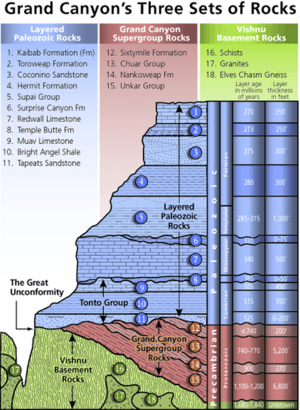
Diagram showing the placement, age and thickness of the rock units exposed in the Grand Canyon.
The result of all the erosion is one of the most complete geologic columns (stacks of rock layers) on the planet. There are nearly 40 major sedimentary rock layers exposed in the Grand Canyon and in the Grand Canyon National Park area. They range in age from about 200 million to nearly 2 billion years old.
Most were laid down in warm, shallow seas, near ancient, long-gone sea shores in western North America. Both marine and terrestrial sediments are represented, including fossilized sand dunes from an ancient desert. There are at least 14 known unconformities in the geologic record found in the Grand Canyon area.
The major rock exposures in the Grand Canyon range in age from the almost 2 billion year old Vishnu Schist at the bottom of the Inner Gorge to the 230 million year old Kaibab Limestone on the rim.
There is a gap of about one billion years shown in the diagram between the stratum that is about 500 million years old (blue) and the lower level, which is about 1.5 billion years old at the top (green). This large unconformity indicates a period of erosion between two periods of deposition.
Many of the formations were deposited in warm shallow seas, near-shore environments (such as beaches), and swamps. The seashore repeatedly advanced and retreated over the edge of a proto-North America.
The great depth of the Grand Canyon and especially the height of its strata (most of which formed below sea level) was caused by a 5,000 to 10,000 feet (1500 to 3000 m) uplift of the Colorado Plateau. This started about 65 million years ago during the Laramide period of orogeny (mountain-building). This uplift steepened the gradient of the Colorado River and its tributaries, which increased their speed and their ability to cut through rock.
Weather conditions during the ice ages also increased the amount of water in the Colorado River drainage system. The ancestral Colorado River responded by cutting its channel faster and deeper.
The base level and course of the Colorado River (or its ancestral equivalent) changed 5.3 million years ago when the Gulf of California opened and lowered the river's base level (its lowest point). This increased the rate of erosion and cut nearly all of the Grand Canyon's current depth by 1.2 million years ago. The stepped appearance of the rocks was caused by their varied resistance to the flow of water.
Between three million and 100,000 years ago, volcanic activity spread ash (tuff) and lava over the area and at times completely blocked the river. These volcanic rocks are the youngest in the canyon.
Biology and ecology
Plants
There are approximately 1,737 known species of vascular plants, 167 species of fungi, 64 species of moss and 195 species of lichen found in Grand Canyon National Park. This variety is largely due to the 8,000 foot (2,400 m) elevation change from the Colorado River up to the highest point on the North Rim. Grand Canyon boasts a dozen endemic plants (known only within the Park's boundaries) while only ten percent of the Park's flora is exotic. Sixty-three plants found here have been given special status by the U.S. Fish and Wildlife Service.
The Mojave Desert influences the western sections of the canyon, Sonoran Desert vegetation covers the eastern sections, and ponderosa and pinyon pine forests grow on both rims.
Natural seeps and springs percolating out of the canyon walls are home to 11% of all the plant species found in the Grand Canyon. The canyon itself can act as a connection between the east and the west by providing corridors of appropriate habitat along its length. The canyon can also be a genetic barrier to some species, like the tassel-eared squirrel.
The aspect, or direction a slope faces, also plays a major role in adding diversity to the Grand Canyon. North-facing slopes receive about one-third the normal amount of sunlight, so plants growing there are similar to plants found at higher elevations, or in more northern latitudes. The south-facing slopes receive the full amount of sunlight and are covered in vegetation typical of the Sonoran Desert.
Animals
Of the 90 mammal species found along the Colorado River corridor, 18 are rodents and 22 are bats.
Life zones and communities
The Park contains several major ecosystems. Its great biological diversity can be attributed to the presence of five of the seven life zones and three of the four desert types in North America. The five life zones represented are the Lower Sonoran, Upper Sonoran, Transition, Canadian, and Hudsonian. This is equivalent to traveling from Mexico to Canada. Differences in elevation and the resulting variations in climate are the major factors that form the various life zones and communities in and around the canyon. Grand Canyon National Park contains 129 vegetation communities, and the composition and distribution of plant species is influenced by climate, geomorphology and geology.
Lower Sonoran
The Lower Sonoran life zone spans from the Colorado River up to 3,500 feet (1,100 m). Along the Colorado River and its perennial tributaries, a riparian community exists. Coyote willow, arrowweed, seep-willow, western honey mesquite, catclaw acacia, and exotic tamarisk (saltcedar) are the predominant species. Hanging gardens, seeps and springs often contain rare plants such as the white-flowering western redbud, stream orchid, and Flaveria mcdougallii. Endangered fish in the river include the humpback chub and the razorback sucker.
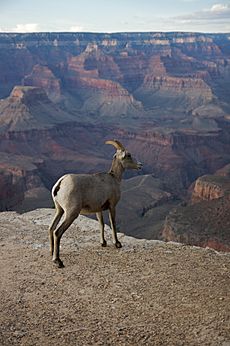
The three most common amphibians in these riparian communities are the canyon tree frog, red-spotted toad, and Woodhouse's Rocky Mountain toad. Leopard frogs are very rare in the Colorado River corridor, they have undergone major declines and have not been seen in the Canyon in several years. There are 33 crustacean species found in the Colorado River and its tributaries within Grand Canyon National Park. Of these 33, 16 are considered true zooplankton organisms.
Only 48 bird species regularly nest along the river, while others use the river as a migration corridor or as overwintering habitat. The bald eagle is one species that uses the river corridor as winter habitat.
River otters may have disappeared from the park in the late 20th century, and muskrats are extremely rare. Beavers cut willows, cottonwoods, and shrubs for food, and can significantly affect the riparian vegetation. Other rodents, such as antelope squirrels and pocket mice, are mostly omnivorous, using many different vegetation types. Grand Canyon bats typically roost in desert uplands, but forage on the abundance of insects along the river and its tributaries. In addition to bats, coyotes, ringtails, and spotted skunks are the most numerous riparian predators and prey on invertebrates, rodents, and reptiles.
Raccoons, weasels, bobcats, gray foxes, and mountain lions are also present, but are much more rare. Mule deer and desert bighorn sheep are the ungulates that frequent the river corridor. Since the removal of 500 feral burros in the early 1980s, bighorn sheep numbers have rebounded. Mule deer are generally not permanent residents along the river, but travel down from the rim when food and water resources there become scarce.
The insect species commonly found in the river corridor and tributaries are midges, caddis flies, mayflies, stoneflies, black flies, mites, beetles, butterflies, moths, and fire ants. Numerous species of spiders and several species of scorpions including the bark scorpion and the giant desert hairy scorpion inhabit the riparian zone.
Eleven aquatic and 26 terrestrial species of mollusks have been identified in and around Grand Canyon National Park. Of the aquatic species, two are bivalves (clams) and nine are gastropods (snails). Twenty-six species of terrestrial gastropods have been identified, primarily land snails and slugs.
There are approximately 41 reptile species in Grand Canyon National Park. Ten are considered common along the river corridor and include lizards and snakes. Lizard density tends to be highest along the stretch of land between the water's edge and the beginning of the upland desert community. The two largest lizards in the canyon are gila monsters and chuckwallas. Many snake species, which are not directly dependent on surface water, may be found both within the inner gorge and the Colorado River corridor. Six rattlesnake species have been recorded in the park.
Above the river corridor a desert scrub community, composed of North American desert flora, thrives. Typical warm desert species such as creosote bush, white bursage, brittlebush, catclaw acacia, ocotillo, mariola, western honey mesquite, four-wing saltbush, big sagebrush, blackbrush and rubber rabbitbrush grow in this community. The mammalian fauna in the woodland scrub community consists of 50 species, mostly rodents and bats. Three of the five Park woodrat species live in the desert scrub community.
Except for the western (desert) banded gecko, which seems to be distributed only near water along the Colorado River, all of the reptiles found near the river also appear in the uplands, but in lower densities. The desert gopher tortoise, a threatened species, inhabits the desert scrublands in the western end of the park.
Some of the common insects and animals found at elevations above 2,000 feet (610 m) are orange paper wasps, honey bees, black flies, tarantula hawks, stink bugs, beetles, black ants, and monarch and swallowtail butterflies. Solifugids, wood spiders, garden spiders, black widow spiders, peacocks, and tarantulas can be found in the desert scrub and higher elevations.
Upper Sonoran and Transition
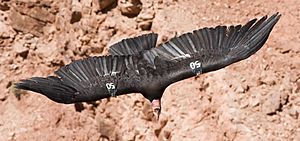
The Upper Sonoran Life Zone includes most of the inner canyon and South Rim at elevations from 3,500 to 7,000 feet (1,100 to 2,100 m). This zone is generally dominated by blackbrush, sagebrush, and pinyon-juniper woodlands. Elevations of 3,500 to 4,000 feet (1,100 to 1,200 m) are in the Mojave Desert Scrub community of the Upper Sonoran. This community is dominated by the four-winged saltbush and creosote bush; other important plants include Utah agave, narrowleaf mesquite, ratany, catclaw acacia, and various cacti species.
Approximately 30 bird species breed primarily in the desert uplands and cliffs of the inner canyon. Virtually all bird species present breed in other suitable habitats throughout the Sonoran and Mohave deserts. The abundance of bats, swifts, and riparian birds provides ample food for peregrines, and suitable eyrie sites are plentiful along the steep canyon walls. Also, several critically endangered California condors that were re-introduced to the Colorado Plateau on the Arizona Strip, have made the eastern part of the Park their home.
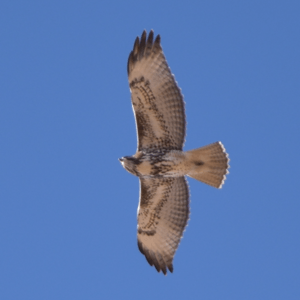
Red-tailed Hawk flying at the south rim of Grand Canyon
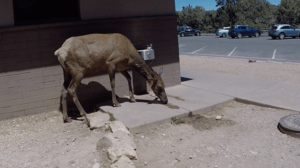
An elk searching for water at Grand Canyon National Park in 2018.
The conifer forests provide habitat for 52 animal species. Porcupines, shrews, red squirrels, tassel eared Kaibab and Abert's squirrels, Indian peacocks, black bear, mule deer, and elk are found at the park's higher elevations on the Kaibab Plateau.
Above the desert scrub and up to 6,200 feet (1,900 m) is a pinyon pine forest and one seed juniper woodland. Within this woodland one can find big sagebrush, snakeweed, Mormon tea, Utah agave, banana and narrowleaf Yucca, winterfat, Indian ricegrass, dropseed, and needlegrass. There are a variety of snakes and lizards here, but one species of reptile, the mountain short-horned lizard, is a particularly abundant inhabitant of the piñon-juniper and ponderosa pine forests.
Ponderosa pine forests grow at elevations between 6,500 and 8,200 feet (2,000 and 2,500 m), on both North and South rims in the Transition life zone. The South Rim includes species such as gray fox, mule deer, bighorn sheep, rock squirrels, pinyon pine and Utah juniper. Additional species such as Gambel oak, New Mexico locust, mountain mahogany, elderberry, creeping mahonia, and fescue have been identified in these forests. The Utah tiger salamander and the Great Basin spadefoot toad are two amphibians that are common in the rim forests. Of the approximately 90 bird species that breed in the coniferous forests, 51 are summer residents and at least 15 of these are known to be neotropical migrants.
Canadian and Hudsonian
Elevations of 8,200 to 9,000 feet (2,500 to 2,700 m) are in the Canadian Life Zone, which includes the North Rim and the Kaibab Plateau. Spruce-fir forests characterized by Engelmann spruce, blue spruce, Douglas fir, white fir, aspen, and mountain ash, along with several species of perennial grasses, groundsels, yarrow, cinquefoil, lupines, sedges, and asters, grow in this sub-alpine climate. Mountain lions, Kaibab squirrels, and northern goshawks are found here.
Montane meadows and subalpine grassland communities of the Hudsonian life zone are rare and located only on the North Rim. Both are typified by many grass species. Some of these grasses include blue and black grama, big galleta, Indian ricegrass and three-awns. The wettest areas support sedges and forbs.

Tourism
| Time | Visitors |
|---|---|
| before WWII | >100,000 |
| 1965 | 1.6 million |
| 2000 | 4.4 million |
| 2019 | 5.9 million |
Many people come from around the world to visit the Grand Canyon. People can also take trips floating on the Colorado River in boats and rafts. Some people like to hike in the Grand Canyon.
The land on the north side of the Grand Canyon is called the North Rim. The land on the south side of the Grand Canyon is called the South Rim. The North Rim is open to visitors from May to October. It is possible to visit the South Rim all year round.
There are trails leading from the North Rim and the South Rim to the bottom of the canyon. These trails lead to a place at the bottom of the canyon called Phantom Ranch. Phantom Ranch has a campground and cabins where hikers can spend the night. Some people also ride mules into the Grand Canyon. Most people who visit the Grand Canyon drive in cars to the South Rim and just look at the canyon from the rim and take pictures. The are also free shuttles for visitors. They are a good way to go from one viewpoint to another. Many tourists like to fly over the canyon in a helicopter to have a panoramic view.
Grand Canyon admission is $35 per car. People accessing by foot or bicycle have to pay $20. Admission to Grand Canyon is included in the National Parks & Federal Recreational Lands Annual Pass ($80), which is valid to enter all National Park in United States for a year.
- List of World Heritage Sites in the United States
- Canyon
Images for kids
-

Grand Canyon, Arizona, Nevada, Lake Powell to Lake Mead, June 27, 2017, Sentinel-2 true-color satellite image. Scale 1:450,000.
-

La conquista del Colorado (2017), by Augusto Ferrer-Dalmau, depicts Spanish Captain García López de Cárdenas 1540 expedition
-

William Bell's photograph of the Grand Canyon, taken in 1872 as part of the Wheeler expedition
-

Smoke from prescribed fires on the South Rim, as seen from Yavapai Point, April 2007.
-

Natural fog sometimes fills the canyon, during temperature inversions
-
Rockfalls in recent times, along with other mass wasting, have further widened the canyon
-

-

A storm over the Grand Canyon
-
Grand Canyon covered with snow
-

Rafters in the Grand Canyon pass one of the rapids of the (mud-)"colored" Colorado River
-

Grand Canyon rescue helicopter, 1978
All content from Kiddle encyclopedia articles (including the article images and facts) can be freely used under Attribution-ShareAlike license, unless stated otherwise. Cite this article:
Grand Canyon Facts for Kids. Kiddle Encyclopedia.
Grand Canyon Water Erosion Kid Drawing
Source: https://kids.kiddle.co/Grand_Canyon

